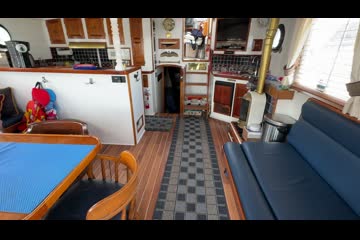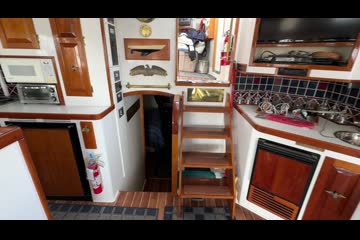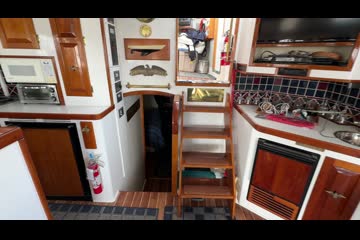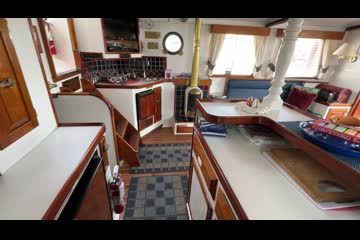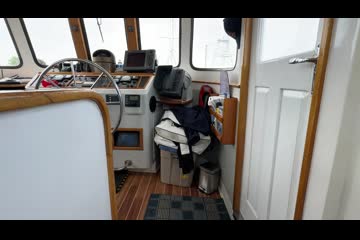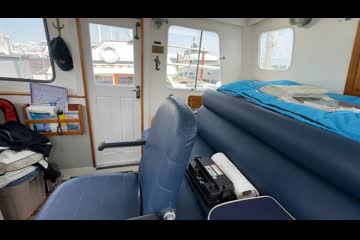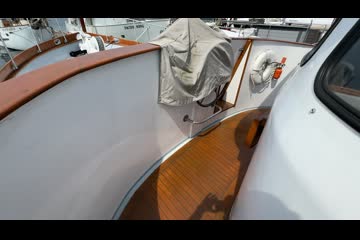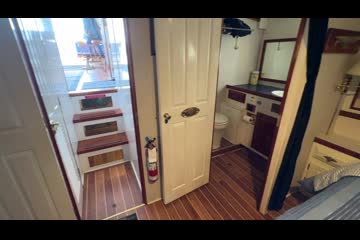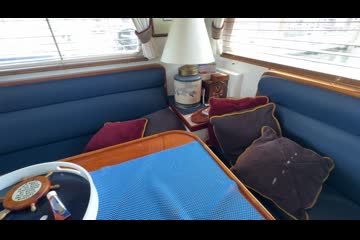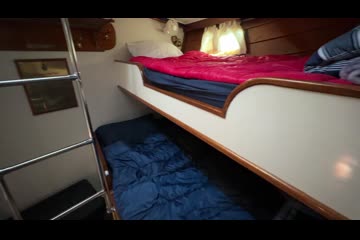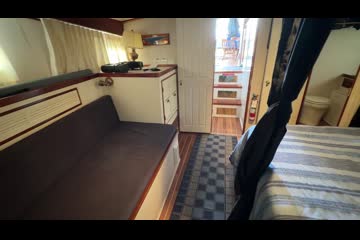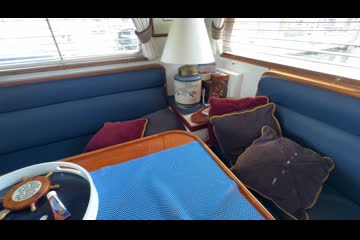Engine
John Deere John Deere 6068TFM01
Total Power
480hp
Engine Hours
1637
Class
Power Pilothouse
Length
14.33m
Year
1967
Model
Pilothouse
Capacity
-
Calibre Yacht Sales
Boat Details
Description
Introducing the remarkable 1967 Willard Pilothouse, a stunning vessel that combines classic design with modern performance. With an overall length of 47 feet, this boat boasts a robust fiberglass hull shaped in a modified Vee, ensuring stability and agility on the water. Powered by two reliable John Deere inboard engines, each delivering 240 horsepower, it offers a cruising speed of 8 knots and a maximum hull speed of 15 knots, making it perfect for leisurely voyages or spirited adventures. The KLATAWA is equipped with durable bronze 4-blade propellers, enhancing its efficiency and maneuverability with a 2000 mile range. Designed for comfort and functionality, this pilothouse model provides a cozy space for relaxation and enjoyment. With a well-maintained engine history, this vessel is ready to embark on new journeys, promising unforgettable experiences on the open water. Experience the charm and capability of the KLATAWA, where timeless craftsmanship meets exceptional performance. Own a piece of nautical history!
The Willard 1967 47ft Pilothouse Yacht, often referred to as the Willard Marine 47 Dover Pilothouse, is a classic trawler yacht renowned for its robust construction, seaworthiness, and suitability for long-range cruising or liveaboard life. Built by Willard Marine in Costa Mesa, California, this vessel reflects the company’s legacy as the first production builder of fiberglass trawler yachts, starting with the Vega 36 in 1961. The 47ft model, introduced in the 1960s, was designed for durability and comfort, embodying a blend of maritime heritage and practical functionality. Below is a detailed overview of its history and specifications based on available information.
History
- Willard Marine Legacy: Founded in 1957 by Bill Tighe in Costa Mesa, California, Willard Marine pioneered the production of fiberglass trawler yachts. The company built a reputation for creating solid, no-nonsense, full-displacement cruising boats, initially designed by naval architects like William Garden and later adapted by designers such as Blaine Seeley. Willard’s trawlers were known for their military-grade construction, with many vessels built to high standards for both recreational and military use. The company ceased recreational boat production in 2003 to focus on military and commercial vessels but left a lasting legacy in the trawler community.
- 1967 Willard 47ft Pilothouse: The 47ft Dover Pilothouse, introduced in the 1960s, was part of Willard’s larger trawler lineup, which included 30, 36, 40, and 47-foot hulls. Unlike the earlier Vega series (e.g., Vega 36, discontinued in 1970), the 47ft model was a semi-displacement design, offering a balance between stability and efficiency for coastal and offshore cruising. It was marketed as a “blue water cruiser” capable of handling rough conditions, making it popular among serious cruisers and those seeking a piece of nautical history. The 1967 model, in particular, is celebrated for its thick, hand-laminated fiberglass hull and timeless design.
- Cultural Significance: Willard trawlers, including the 47ft Pilothouse, have a dedicated following, with owners gathering annually since 1992 to celebrate their rugged simplicity and seaworthiness. The 47ft model has been praised for its ability to undertake long passages, such as multiple trips along the Inside Passage to Alaska, and remains sought after for its robust construction and classic appeal.
Specifications
The specifications below are compiled from listings and descriptions of the 1967 Willard 47ft Pilothouse, particularly the “Dover” model.
General Specifications
- Length Overall (LOA): 47 feet
- Beam: 15 feet 7 inches
- Draft: Approximately 5–6 feet (deep draft typical for displacement hulls)
- Displacement: Full-displacement or semi-displacement hull, with estimates around 40,000–50,000 lbs (exact weight varies by equipment)
- Hull Material: Hand-laminated fiberglass, 1.5 inches thick, with gelcoat exterior
- Deck and Superstructure: Fiberglass over marine plywood, with double-layer fiberglass sheathing; non-skid decks painted with Awlgrip or similar coatings
- Hull Type: Semi-displacement, hard-chined hull designed for stability and seaworthiness
- Designer: Blaine Seeley (adapted from earlier Willard designs)
- Builder: Willard Marine, Costa Mesa, California
Accommodations
- Staterooms: 2
- Master Stateroom: Midship with a double bed, vanity/sink, and private head with shower to port
- Crew/Guest Quarters: Forward with berths to port and starboard, adjacent to a crew’s head
- Heads: 2 (one for master, one for crew/guest)
- Saloon: Large, open saloon with 270-degree visibility, wraparound windows, dining table to port, and seating to starboard
- Galley: U-shaped, located in the saloon to port, with double stainless steel sink, bar top for serving, and appliances.
- Pilothouse: Raised, accessed via steps from the saloon, with a large helm station, bench seating (convertible to a single berth), chart table, and modern electronics.
- Sleeping Capacity: Up to 8 berths (including convertible dinette and pilothouse bench)
- Storage: Ample storage throughout, including cedar-lined hanging lockers in staterooms
Mechanical and Propulsion
- Twin John Deere electronic diesels (315 hp each, repowered in 2014) for reliability and fuel economy
- Propulsion: Twin screws with protected props, suitable for long-range cruising
- Fuel Capacity: Approximately 600 gallons (four 150-gallon FRP tanks for engines, one 100-gallon stainless steel tank for heating system)
- Water Capacity: Approximately 100 gallons (one stainless steel tank forward)
- Cruising Speed: 6–8 knots (fuel-efficient at lower speeds)
- Range: Estimated 1,000–2,000 nautical miles at 6 knots, depending on engine efficiency and tankage
- Stabilization: Features hydraulic stabilization for improved comfort in rough seas
- Bow Thruster: Hydraulic bow thruster
- Generator
- Heating: Diesel heat system for extended cruising in colder climates
Deck and Exterior
- Foredeck: Equipped with a bench (with storage underneath), life raft mounting, and windlass
- Side Decks: Wide, with continuous stainless steel railings for safe movement
- Cockpit: Aft cockpit, covered, with a transom door to starboard leading to a teak swim platform
- Portuguese Bridge: Aft of the foredeck, providing additional protection and visibility
- Flybridge: with access from pilothouse doors
- Mast: Folding aluminum mast for boathouse storage, equipped with LED searchlight
- Davit System: davits on transom
Navigation and Safety
- Electronics: Modern refits include:
- Furuno Navnet plotter with integrated radar
- Remote Furuno plotter for Portuguese bridge
- ICOM radios, hailer, fog horn, GPS, and Class A AIS
- Engine room camera system
- Last Watch alarm system
- Safety Equipment:
- 6-person offshore life raft
- CQR anchor
- Stainless steel railings replacing lifelines
- Emergency alarm bell system
- Electrical: Rewired to modern standards in many vessels, with expanded breaker systems to support new instrumentation
Performance and Cruising
- Seaworthiness: The 1.5-inch-thick fiberglass hull and semi-displacement design make it exceptionally sturdy, capable of handling rough seas. Owners report multiple Inside Passage trips to Alaska, including cruises to Tracy Arm and Glacier Bay, demonstrating its reliability for extended voyages.
- Fuel Efficiency: At 6–7 knots, the Willard 47 achieves excellent fuel economy, with some owners reporting less than 1 gallon per hour per engine in twin setups.
- Liveaboard Comfort: The spacious interior, large saloon, and practical layout make it ideal for extended living aboard, with visibility and entertaining spaces (e.g., enclosed aft deck) enhancing the experience.
Notable Features and Upgrades
- Robust Construction: The hand-laminated 1.5-inch fiberglass hull and military-grade build quality ensure durability. Willard’s experience building for the U.S. military contributed to the yacht’s ruggedness.
- Refits and Modernization: Many 1967 models, like the “Klatawa,” have undergone extensive refits (e.g., 2007–2008 and 2014 at Port Townsend Shipwrights Co-op), including repowering with modern diesels, updated electronics, NuTeak flooring, and rewired electrical systems.
- Versatility: Suitable for long-range cruising, liveaboard life, or coastal exploration, with a layout that accommodates families, couples, or solo cruisers.
- Classic Appeal: The yacht’s old-world charm, combined with modern upgrades, makes it a standout for those seeking a blend of history and functionality.
Market and Availability
- Availability: These yachts are rare due to limited production and high demand among trawler enthusiasts.
- Ownership Community: The Willard Boat Owners group (on Groups.io) and annual gatherings (e.g., Anacortes, WA) provide resources and camaraderie for owners, with databases like willardboats.org tracking hull numbers and histories.
- Historical Context: While Willard’s reputation for quality is well-earned, the 47ft model’s semi-displacement hull differs from the full-displacement Vega series, offering slightly less efficiency but greater stability in varied conditions.
Contact Information
Other Details
Disclaimer
The Company offers the details of this vessel in good faith but cannot guarantee or warrant the accuracy of this information nor warrant the condition of the vessel. A buyer should instruct his agents, or his surveyors, to investigate such details as the buyer desires validated. This vessel is offered subject to prior sale, price change, or withdrawal without notice.
Features
Electrical Equipment
Shore Power Inlet:✓
Generator:✓
Inverter:✓
Electronics
Depthsounder:✓
Radar:✓
Radar Detector:✓
Wind Speed and Direction:✓
TV Set:✓
Navigation Centre:✓
VCR:✓
Plotter:✓
DVD Player:✓
Autopilot:✓
Radio:✓
Compass:✓
CD Player:✓
GPS:✓
Cockpit Speakers:✓
VHF:✓
Flat Screen TV:✓
Inside Equipment
Bow Thruster:✓
Electric Bilge Pump:✓
Oven:✓
Microwave Oven:✓
Marine Head:✓
Heating:✓
Hot Water:✓
Refrigerator:✓
Deep Freezer:✓
Battery Charger:✓
Outside Equipment
Davit(s):✓
Radar Reflector:✓
Tender:✓
Liferaft:✓
Cockpit Table:✓
Swimming Ladder:✓
Additional Equipment
Walk Around:✓
Propulsion
Engine 1
Engine Make:John Deere
Engine Model:John Deere 6068TFM01
Total Power:240hp
Engine Hours:1637
Engine Type:Inboard
Drive Type:Direct Drive
Fuel Type:Diesel
Propeller Type:4 Blade
Propeller Material:Bronze
Engine 2
Engine Make:John Deere
Engine Model:6068TFM01
Total Power:240hp
Engine Hours:1644
Engine Type:Inboard
Drive Type:Direct Drive
Fuel Type:Diesel
Propeller Type:4 Blade
Propeller Material:Bronze
Specifications
Speed & Distance
Cruising Speed:8kn
Max Speed:18kn
Dimensions
Length Overall:14.33m
Max Draft:1.27m
Beam:4.62m
Miscellaneous
Hull Material:Fibreglass
Tanks
Fresh Water Tank:1 x
Fuel Tank:1 x 3785.41 l
Holding Tank:1 x 283.91 l

























































































